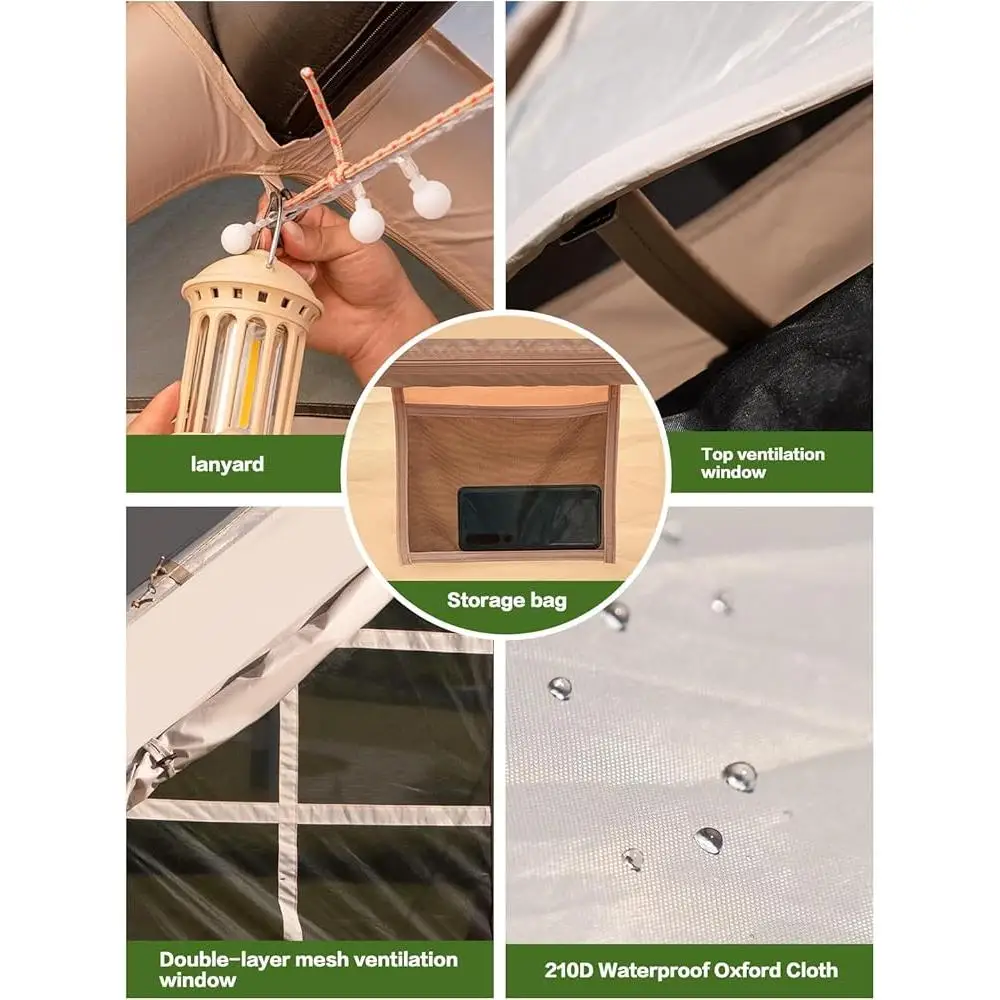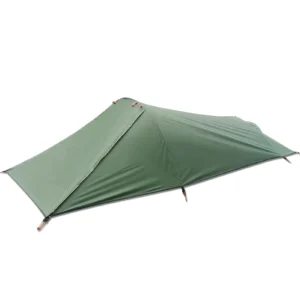Understanding Tent Pole Fundamentals
Tent poles form the skeleton of your shelter, creating the structure that transforms a piece of fabric into a safe haven in the outdoors. These seemingly simple components play a crucial role in determining your tent’s stability, weather resistance, and overall performance.
When properly installed, tent poles create tension across the fabric, establishing a sturdy framework that withstands wind, rain, and other elements. They define the shape of your living space and contribute significantly to how well your tent performs in challenging conditions.
So, are tent poles interchangeable? The straightforward answer is generally no—with some specific exceptions. Tent poles are typically designed for particular tent models with precise specifications for:
- Diameter and length measurements
- Curvature and pre-bent sections
- Connection systems and end fittings
- Material properties and flexibility characteristics
Using incorrect poles can lead to serious consequences:
* Damage to your tent fabric from excessive stress
* Compromised structural integrity in severe weather
* Difficulty in proper setup and takedown
* Potential collapse during critical situations
Understanding shelter options for two campers provides valuable context for appreciating how tent pole systems contribute to overall shelter performance and why compatibility matters so much.
Critical Factors That Determine Tent Pole Compatibility
Diameter Differences
The diameter of a tent pole is perhaps the most critical factor in determining compatibility. Common diameters include 7.9mm, 8.5mm, 9.5mm, and 11mm, though many variations exist. Using poles that are too thin can result in instability and potential collapse, while poles that are too thick may damage your tent’s pole sleeves or attachment points.
Length Precision
Tent poles must be precisely the right length to create proper tension across the tent body. Even small differences in length can drastically alter your tent’s geometry, affecting stability and weather resistance. Many modern tents incorporate complex pole structures with multiple sections of varying lengths, making exact replacements essential.
Material Variations
Different materials offer distinct characteristics:
* Fiberglass: More affordable but heavier and less durable
* Aluminum: Lightweight with good strength-to-weight ratio
* Carbon fiber: Ultra-lightweight but expensive
* Steel: Heavy but extremely strong for larger camping tents
These materials cannot simply be swapped as they bend, flex, and respond to stress differently.
Shock Cord Variations
The elastic cord running through sectional poles varies in thickness and tension requirements. Improper shock cord tension can make setup difficult or compromise structural integrity.
Brand-Specific Designs
Many manufacturers use proprietary connection systems, hub configurations, or specialized pole structures that are incompatible with other brands’ components.
Understanding the relationship between compatible trekking poles and tents can provide additional insights into pole specifications and how they impact tent performance.
How Pole Materials Impact Interchangeability and Performance
The material of your tent poles significantly affects whether they can interchange with others and how they perform in the field:
Fiberglass Poles
- Strength: Moderate but prone to splintering when damaged
- Weight: Relatively heavy compared to alternatives
- Flexibility: Good flex but can snap under extreme pressure
- Weather Performance: Reasonable in moderate conditions, but may weaken over time with UV exposure
- Price: Most economical option
Aluminum Poles
- Strength: Excellent strength-to-weight ratio
- Weight: Lightweight (typically 30-50% lighter than fiberglass)
- Flexibility: Bends under pressure rather than breaking suddenly
- Weather Performance: Performs well across various conditions
- Price: Mid-range, though aircraft-grade aluminum commands a premium
Carbon Fiber Poles
- Strength: Exceptional strength at minimal weight
- Weight: Ultralight (can be 60% lighter than fiberglass)
- Flexibility: Less flexible but very resilient
- Weather Performance: Excellent in all conditions
- Price: Premium, often 2-3 times the cost of aluminum
Steel Poles
- Strength: Maximum durability and load-bearing capacity
- Weight: Very heavy, limiting portability
- Flexibility: Minimal flex, excellent for standing height tents
- Weather Performance: Superior stability in extreme conditions
- Price: Moderate for basic steel, higher for specialty alloys
Different freestanding backpacking tents utilize specific pole materials to balance weight, durability, and performance characteristics, making material a critical factor in replacement considerations.
Tent Pole Connection Systems and End Fittings
The way tent poles connect to each other and to the tent body creates another layer of compatibility challenges:
Ferrule Types
- Male/female connections allow sections to join securely
- Diameter variations between brands prevent interchangeability
- Material differences affect durability and weight
- Specialized ferrules may incorporate angle adjustments or reinforcements
End Tips and Terminations
- Pin insertion tips that fit into grommets or webbing pockets
- Ball-end tips designed for specific connection systems
- Flattened ends for sleeve-style tents
- Specialized tips for hub-based designs
Tent Attachment Methods
- Sleeve systems that poles thread through
- Clip attachments that snap onto the pole exterior
- Combination systems with both sleeves and clips
- Hook-and-loop fasteners for specialized designs
- Hub-based connections for complex geometric structures
These attachment systems are rarely standardized between manufacturers, or even between different models from the same manufacturer.
The principles of proper lightweight tent setup demonstrate how these connection systems work together to create a functional shelter and why matching them correctly matters.
When Tent Pole Interchange Is Possible: Compatible Scenarios
Despite the challenges, there are situations where tent poles can successfully interchange:
Same-brand, same-model replacements: The most reliable option is replacing poles with identical components from the same manufacturer and tent model. Even slight variations between production years can sometimes be accommodated.
Universal replacement sections: For emergency repairs, universal pole sections with adjustable ferrules can replace broken segments, though these are temporary solutions rather than perfect matches.
Similar tent designs with identical specifications: Occasionally, poles from different models may share identical specifications, particularly from the same manufacturer’s product line or when manufacturers source components from the same suppliers.
Adapter solutions: Some specialty outdoor repair companies create custom adapters to connect otherwise incompatible pole systems, though these add weight and potential failure points.
Completely universal systems: Some ultralight trekking pole tents are designed to work with standard hiking poles rather than dedicated tent poles, offering flexibility across brands.

Finding the Perfect Replacement Poles: Complete Measurement Guide
To find compatible replacement poles, precise measurement is essential:
Measuring Diameter
- Use digital calipers for highest accuracy (or a ruler for estimation)
- Measure both the outside diameter of poles and the inside diameter of ferrules
- Common sizes include 7.9mm, 8.5mm, 9.5mm, and 11mm, but record your exact measurements
- Check multiple sections, as some tents use different diameters in different areas
Measuring Length
- Fully assemble the pole if possible
- Measure from tip to tip along the natural curve
- If measuring individual sections, include the inserted portion of ferrules
- Record both the total assembled length and individual section lengths
Documenting Pole Shape
- Photograph assembled poles against a grid background
- Note any pre-curved sections and their bend angles
- Measure the height of the curve from a flat surface
- Document special features like hub attachments or unique end fittings
For Damaged or Missing Poles
- Use the tent’s setup instructions to determine original pole configuration
- Contact the manufacturer with your tent model and production year
- Measure the tent body itself to estimate pole requirements
- Consider a matching tent of the same model to measure against
When choosing compact shelters for two, understanding proper measurement techniques ensures you’ll have the right components for a successful setup.
Universal Replacement Kits: When and How They Work
Universal replacement kits offer a potential solution when exact matches aren’t available:
Types of Universal Kits
- Sectional kits with various diameter options
- Repair splints for emergency fixes
- Complete pole sets with customizable lengths
- Shock cord replacement packages with various diameters
Selecting the Right Kit
- Match diameter first and foremost (most critical factor)
- Choose appropriate material based on your tent’s requirements
- Ensure adequate length for your specific tent model
- Consider weight implications, especially for backpacking
Pros of Universal Kits
- Readily available in outdoor stores and online
- Generally more affordable than manufacturer replacements
- Quick solution for emergency situations
- Often include extra components for future repairs
Cons of Universal Kits
- Rarely provide perfect fit and tension
- May require customization or trimming
- Potential compatibility issues with specialized connection systems
- Usually heavier than original equipment
- May not match the strength characteristics of originals
Universal kits work best for simple tent designs with standard pole configurations, but even heavy-duty 4-season tents sometimes require specialized poles that universal kits cannot adequately replace.
Manufacturer-Specific Replacement Options: Getting Exact Matches
When precision matters most, contacting the original manufacturer offers the best solution:
- Most reputable tent manufacturers sell replacement parts directly to customers
- Provide your tent model, production year, and specific pole location in the tent
- Expect to pay premium prices for exact replacements ($15-40 per section or $50-150+ for complete pole sets)
- Be prepared for potential delays, especially for discontinued models
- Some manufacturers offer repair services rather than just replacement parts
The main advantages of manufacturer replacements include:
* Perfect fit guaranteed
* Identical materials and performance characteristics
* Maintained warranty coverage (in some cases)
* Proper integration with all connection systems
For lightweight backpacking tents where weight and performance are critical, manufacturer-specific replacements often provide the only truly satisfactory solution.
DIY Tent Pole Repair and Replacement Techniques
With the right tools and techniques, many tent pole problems can be solved through DIY approaches:
Replacing Individual Sections
- Measure the damaged section precisely
- Purchase matching diameter replacement sections
- Remove old shock cord and ferrules if reusable
- Assemble in the same configuration as the original
Re-stringing Shock Cord
- Secure one end with a knot or ferrule cap
- Stretch cord through all sections (using a wire as a guide if needed)
- Apply appropriate tension (30-40% stretch is typical)
- Secure the other end while maintaining tension
Creating Custom Lengths
- Use a tubing cutter or fine-toothed hacksaw for clean cuts
- Smooth edges with fine sandpaper
- Create ferrule seats as needed with proper tools
- Test fit before finalizing assembly
Essential Repair Tools
- Needle-nose pliers
- Fine-toothed hacksaw or tubing cutter
- Measuring tape and calipers
- Shock cord in appropriate diameter
- Replacement ferrules if needed
- File or sandpaper for smoothing cuts
For common dome camping tent designs, these DIY techniques can effectively extend pole life and save money compared to complete replacements.

Field Emergency Repairs: Temporary Solutions When Camping
When poles fail during a trip, these emergency techniques can save your shelter:
- Pole Sleeve Repair: Use a tent stake, trekking pole section, or sturdy stick as an external splint, securing with duct tape or gear repair tape
- Field Splicing: Join broken sections by inserting a tent stake or similar object inside both pieces, then wrapping securely
- Trekking Pole Substitution: For some designs, mastering trekking pole tent setup techniques allows you to substitute hiking poles for damaged tent poles
- Guy Line Compensation: Add extra guy lines to support areas weakened by pole failure
- Partial Setup: In severe damage cases, set up just the functional portion of the tent and use natural features for additional support
Keep these essential emergency repair items in your pack:
* Duct tape or gear repair tape
* Small repair sleeve kit
* Extra guy line
* Multi-tool with pliers
* Knowledge of improvisation techniques
Consequences of Using Incorrect Tent Poles
Using mismatched tent poles can lead to significant problems:
- Fabric Stress and Damage: Incorrectly sized poles create tension points that can tear rainflies, tent bodies, or pole sleeves
- Structural Weakness: Improper pole diameter or strength characteristics may collapse under wind or snow loads
- Compromised Weather Protection: Incorrect pole tension creates sagging areas where rain can pool or wind can catch
- Connection Failures: Mismatched end fittings may slip from grommets or attachment points during adverse conditions
- Accelerated Wear: The constant strain of improper fit accelerates deterioration of both the poles and tent materials
These issues are particularly concerning for winter camping tents where structural integrity can be a safety issue during snow loading or high winds.
Tent Pole Maintenance to Maximize Lifespan
Proper maintenance significantly extends the life of your tent poles:
- Thorough Drying: Always dry poles completely before storage to prevent corrosion of metal components
- Gentle Disassembly: Avoid snapping poles apart; instead, push sections apart from the center outward
- Clean After Exposure: Rinse after beach or desert camping to remove sand and salt
- Regular Inspection: Check ferrules, shock cord, and sections for wear, especially before major trips
- Proper Storage: Store fully disassembled in a dry place at moderate temperatures
- Shock Cord Maintenance: Replace weakened shock cord to prevent sections from separating or misaligning
- Avoid Excessive Stress: Set up on even ground and avoid overtightening to prevent unnecessary strain
Lightweight Backpacking Tent, Ultralight Backpacking Tent, Ultralight Bivy Tent
Ultralight Single Person Camping Tent with Aluminum Poles for 3-Season Backpacking Waterproof DesignPrice range: $94.88 through $326.82 Select options This product has multiple variants. The options may be chosen on the product pageLightweight Backpacking Tent, Ultralight Backpacking Tent, Waterproof Backpacking Tent
$391.05 Select options This product has multiple variants. The options may be chosen on the product pageHeavy Duty 4 Season Tent, Mountaineering Tent, Winter Camping Tent
$870.40 Select options This product has multiple variants. The options may be chosen on the product pageCompact Backpacking Tent, Lightweight Backpacking Tent, Waterproof Camping Tent
$335.52 Select options This product has multiple variants. The options may be chosen on the product pageUltralight Backpacking Tent, Ultralight Dome Tent, Winter Camping Tent
Price range: $369.63 through $370.07 Select options This product has multiple variants. The options may be chosen on the product pageHeavy Duty 4 Season Tent, Ultralight Freestanding Tent, Winter Camping Tent
$3,722.66 Select options This product has multiple variants. The options may be chosen on the product page
Consistent maintenance not only extends lifespan but also ensures your poles will perform reliably when you need them most.

Can You Use Adjustable Poles as Replacements?
Adjustable poles present an interesting alternative for certain situations:
Adjustable trekking or awning poles can work reasonably well for:
* Simple tarp setups
* Awning extensions on vehicle campers
* Emergency replacements for vertical support poles
* Certain designs specifically made for adjustable poles
However, they have significant limitations for structured tent designs:
* Lack of flexibility and curve necessary for dome tents
* Insufficient strength for horizontal spans
* No connection system for pole intersections
* Weight penalties compared to dedicated tent poles
* Limited resistance to lateral forces
While not ideal for most traditional tents, adjustable poles can be valuable additions to your gear for versatility in simple shelter configurations or emergency situations.
Frequently Asked Questions About Tent Pole Replacement
Can fiberglass poles replace aluminum ones?
Yes, but with important caveats. Fiberglass poles of the same diameter can sometimes substitute for aluminum, but they’re typically heavier and less durable. The reverse substitution is more problematic—aluminum poles may be too rigid for designs engineered for fiberglass flexibility.
Are poles from the same brand but different models interchangeable?
Sometimes, but not reliably. Manufacturers often use standardized components across certain product lines, but differences in length, curve, or connection systems are common. Always verify exact specifications rather than assuming compatibility.
How much does replacing tent poles typically cost?
For universal replacement sections: $5-15 per section
For complete universal sets: $20-60 depending on size and material
For manufacturer-specific replacements: $50-150+ for complete sets
For custom fabrication: $75-200+ depending on complexity
Can I make completely custom tent poles?
Yes, with the right materials and tools. Specialized outdoor repair companies offer custom pole fabrication services, or you can purchase components (shock cord, ferrules, pole sections) for DIY assembly.
What’s the lifespan of different pole materials?
Fiberglass: 3-5 years with regular use
Aluminum: 7-10+ years with proper maintenance
Carbon fiber: 10+ years when not damaged
Steel: 10-15+ years for coated steel poles
Are vintage tent poles compatible with modern tents?
Rarely. Tent design has evolved significantly, with modern poles using different materials, diameters, and connection systems than vintage models. Vintage poles typically work only with their original tents.
Understanding tent size requirements is also important when replacing poles, especially when considering if a 2-person tent is big enough for your needs, as this affects the pole structure required.
Expert Tips for Tent Pole Purchasing Decisions
Repair vs. Replace: For single broken sections, repair is economical. If multiple sections or shock cord are damaged, complete replacement often makes more sense.
Upgrade Considerations: When replacing poles, consider upgrading materials (from fiberglass to aluminum, for instance) for better durability and weight savings.
Compare Costs Holistically: Factor in shipping costs and time when comparing manufacturer replacements versus local options.
Quality Indicators: Look for seamless ferrules, consistent anodizing (for aluminum), and smooth section connections as signs of quality replacement poles.
Specialized Services: For complex or high-end tents, consider professional pole fabrication services that can custom-match your exact requirements.
Material Selection: Choose materials appropriate for your usage—aluminum for backpacking, fiberglass for occasional camping, and carbon fiber for ultralight applications.
Innovations in Tent Pole Technology and Future Trends
The tent pole market continues to evolve with exciting innovations:
Airbeam technology is increasingly replacing traditional poles in some designs, using inflatable tubes that provide comparable strength with simplified setup. These eliminate pole breakage concerns but introduce puncture risks.
New composite materials blend the best properties of traditional materials—the lightness of carbon fiber with the durability of aluminum—though often at premium price points.
Hub-based systems with pre-attached pole sections are gaining popularity, simplifying setup while reducing the risk of lost sections. These integrated designs can be more challenging to repair in the field but offer superior convenience.
Environmental considerations are also driving change, with manufacturers developing more sustainable materials and production processes for pole components.
For most campers, understanding these innovations helps inform purchasing decisions, especially when considering upgrade options during necessary replacements.







